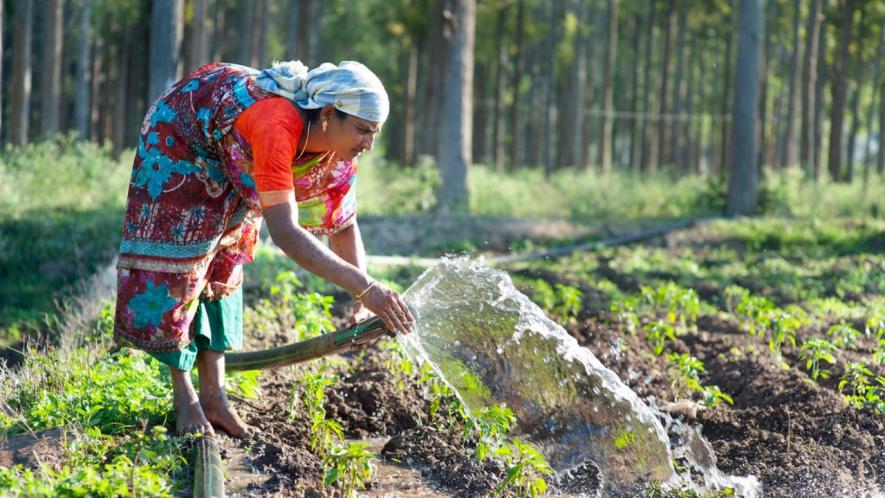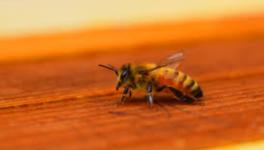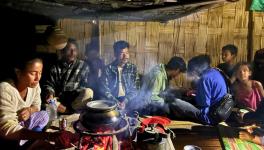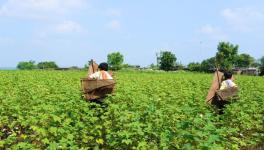Madhya Pradesh: The Rise and Fall of an Organic Farming Village in Khandwa

Representational Image. Image Courtesy: Flickr
Khandwa, Madhya Pradesh: Olfactory discomfort is at its peak as the strong, sickening odour of pesticides and the earthy smell of cow dung waft through Malgaon in Khandwa district of Madhya Pradesh. Not a single farm in this village with 447 houses and 2,488 residents is fully organic, but that was not the case over 20 years ago.
At that time, the family of Deepak Patel (37) was among the first to switch to organic practices by building three Nadep structures at their farm and another three on the premises of their house using their own resources. The family dumped organic waste in these earthen structures throughout the year to make compost.
“Our farm was fully organic for only four years. Due to climate change and rising pest attacks, we were forced to switch to pesticides,” Deepak tells 101Reporters, while acknowledging that organic farming is the best option, provided farmers get better prices for their produce. He wants to move away from chemical-based farming, so 40% of the total pesticides used in his farm are organic now.
Temikala-based Jagannath Kanade (75) has been a farmer for the last 60 years. He says predicting even the next day’s weather is a difficult task these days. “It sometimes looks like summer, then suddenly it rains or fog spreads. All these have increased pest attacks in crops. We have no option but to resort to pesticides to keep them in check.”
According to Kanade, farmers now spend three times more money on their crops than earlier because chemical-based farming is very expensive. In fact, more money is being spent on fertilisers and pesticides than seeds, ultimately taking away soil fertility.
Even the weather forecast app is not to their aid. Durgaram Patel (35) says farmers used to get weather information on the app, but there was a problem. “The app would be showing a clear weather, but it will be raining outside. Tell me how can we decide anything in such a situation,” he asks.
Durgaram’s fields used to deliver 20 sacks of wheat earlier. But in the last five years, he has been getting only five to seven sacks. “If this situation prevails, farmers will have to find other means to earn their livelihood,” he warns.
Farmers are fully aware that the continuous application of pesticides will make their land barren in future, but they say they do not have an option. “We have harmed ourselves by leaving organic farming. Going back to organic methods is difficult now. Farmers are trying to include some organic practices, like using 20% organic inputs. A complete switch is not easy, but it will be required to save our land,” says Kamlesh Patel (36), a farmer from Temikala.
Malgaon farmer Hukumchand Patel (57) tells 101Reporters that the village did only organic farming from 2000 to 2005. “People from far and wide used to come here to learn about organic farming. I also followed organic farming during that period and got good results. Later, production decreased and the weather did not cooperate. Since the village is situated at a higher altitude, there was a water shortage. We filled this deficiency with pesticides. Within no time the situation changed and chemical-based farming increased in the entire village,” he recalls.
Rajesh Gupta, the then chief executive officer of district panchayat, had taken special interest in developing Malgaon as an organic village and Torani as a water village. Late Hukumchand Patel was the first farmer to initiate organic farming in the village. He also informed other villagers about its long-term benefits and inspired them to do the same. Patel started using the waste from his fields and house to make organic fertiliser by layering it with cow dung.
In 2002, when Malgaon was a fully organic village, works to conserve water were initiated. Rainwater and nutrients flowing from flat land were stored in 7,000 water pits around the village fields. When these pits overflowed, the excess water was diverted towards the village wells. To ensure water efficiency during irrigation, drip irrigation and sprinkler methods were adopted.
Earlier, even a good rainfall could not save the place from water shortage due to the high altitude and rocky ground. At that time, 505 hectares were under cultivation. There were 275 irrigable wells, but only 20 held adequate water. The severe drought between 1998 and 2000 made farmers aware of the need to change their farming practices. They understood the special role of humus and compost in retaining soil moisture, which made them turn to organic farming.
Big farmers of the village set up biogas plants in their homes and gave connections to their neighbours and relatives. Five big and 12 small biogas plants were built in the village in 2002. In 2012, another 218 biogas plants were built by people of the village at subsidised rates. Considering the decrease in cattle population in the village, household toilets were also connected to the plant.
Close to 10 tonnes of organic fertilisers could be obtained from cow dung biogas, 8.9 tonnes from Nadep and 10.12 tonnes from vermicompost. To ensure composting in Nadep structures, 25 collection centres were set up in the village with panchayat help. Due to these efforts, Malgaon received the Nirmal Gram Puraskar in 2009.
However, with cattle rearing decreasing further and people switching back to chemical fertilisers for agriculture, the biogas structures have faded away. Biogas plants have remained buried under cow dung and garbage, while not a single Nadep structure can be seen here. Now farmers collect cow dung in the open and convert it into manure. Today, only two biogas plants are operational in the village.
As per an estimate, 806 quintals of urea, 407 quintals of super phosphate, 125 quintals of potash and 446 quintals of diammonium phosphate (DAP) are annually used in Malgaon. Pesticides to kill caterpillars and other insects are also used.
“The time for caution has passed, now we should start saving what is left. High amounts of pesticides are sprayed in the fields of Khandwa. This indiscriminate use works as a tool to spoil the weather,” Dr Saurabh Gupta, meteorologist, Bhagwantrao Mandloi Agricultural College, Khandwa, tells 101Reporters.
Dr Satish Parsai, an entomologist at the same college, warns that pests have become so powerful that it is difficult to kill them even with pesticides. Hence, traditional methods are more suited.
“If farmers are still not alert and do not return to old methods, the future of agriculture will be even more challenging.”
Malgaon Sewa Sahkari Samiti distributes the government-approved urea, DAP and potash to farmers. In view of the deteriorating health of fields and soil, the government has launched nano fertiliser in the market. The society provides this also to most farmers.
“Over 500 hectares are irrigated in the village. As many as 105 farmers are registered with the samiti, which distributes 320 bags of urea, 400 bags of DAP, 150 bags of phosphate and 70 bags of potash to them. The remaining farmers in the village have to buy fertilisers from the market at a price that is four times higher,” says Krishnakant Sohni, a clerk at the cooperative society.
Mohammad Asif Siddiqui is a Madhya Pradesh-based freelance journalist and a member of 101Reporters, a pan-India network of grassroots reporters.
Get the latest reports & analysis with people's perspective on Protests, movements & deep analytical videos, discussions of the current affairs in your Telegram app. Subscribe to NewsClick's Telegram channel & get Real-Time updates on stories, as they get published on our website.
























